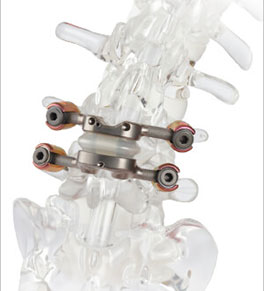An alternative to spinal fusion for lower back pain

Instead of fusing the joints, the implant allows a surgeon to decompress the nerves in a damaged joint segment and stabilize the spine while preserving motion in all directions.
Lumbar spinal stenosis, a narrowing of the spaces in the lower spine, can be painful, debilitating and hard to treat.
However, a new implant now being studied may give patients relief and help preserve their mobility in this crucial area between the ribs and pelvis.
UCI Health is one of 30 centers across the country — and the only one in the Orange County area — participating in a clinical trial to evaluate the effectiveness and safety of the device known as the Premia Spine TOPS™ System.
The implant was developed for patients with moderate to severe lumbar stenosis. It is designed to be an alternative to the current standard of care: spinal fusion, which permanently connects two or more vertebrae, eliminating motion in those bones.
“There’s a trend away from fusion, because it changes the mechanics of the back,” says Dr. Michael Oh, a UCI Health neurosurgeon who specializes in spine surgeries and is the trial’s principal investigator.
Joint replacement for the spine?
“This new device works much like a hip or knee replacement," Oh says. "We know that patients do better with replacement than fusion for hip and knee surgery. We’re studying whether joint replacement will also work in the more complex lumbar spine.”
About 200,000 lumbar spinal fusions are performed each year across the country to relieve severe pain and numbness from the buttocks to the legs, the result of bone and ligaments compressing the nerves. This type of neurogenic pain is made worse by standing and walking, and is relieved by sitting. Patients in pain often become sedentary, which is a risk factor for many other diseases and can lead to muscle degeneration.
Fusion can help alleviate pain and increase spine stability, but it creates some limitations in mobility — about 10 degrees less range of motion, depending on which level is fused. It may also trigger a cycle of disease in an adjacent segment that may lead to additional surgery and significant loss of mobility.
“When you fuse one segment of the spine, it puts more pressure on the segment above or below,” Oh says. “That area may need to be fused within five years, and the next level breaks down even faster. By the time you get a couple of levels fused, things like bending down to tie your shoes become difficult. We’re hoping this device solves that problem.”
Proving effectiveness
The implant, which is made of two titanium plates connected to a polycarbonate urethane boot, replaces parts of one functional segment — two joints. Instead of fusing the joints, the device allows a surgeon to decompress the nerves in the damaged area and stabilize the spine while preserving motion in all directions.
“The surgery involves the same decompression to remove the bone and ligaments that are compressing the nerves, as with a fusion, but replaces them with the artificial lumbar joints,” Oh explains.
The number of joint segments and the unique mechanics of the lumbar spine has made development of a mechanical replacement more complex than for hips and knees. There is no Food and Drug Administration-approved use of this or any similar device for the lower back.
Underway for a year now, the TOPS trial anticipates enrolling a total 300 patients with moderate to severe lumbar stenosis. Two of every three patients are randomly assigned to receive the TOPS implant, while one receives traditional spinal fusion. Patients in the national trial are being followed up at two- and five-year intervals.
“For FDA approval, the trial has to show that TOPS is not worse than fusion,” Oh says. If TOPS doesn’t help, fusion can always be done as a follow-up procedure.
Above all, he says, UCI Health, as an academic medical system, is committed to giving patients access to new treatments and technologies that are not generally available elsewhere.




